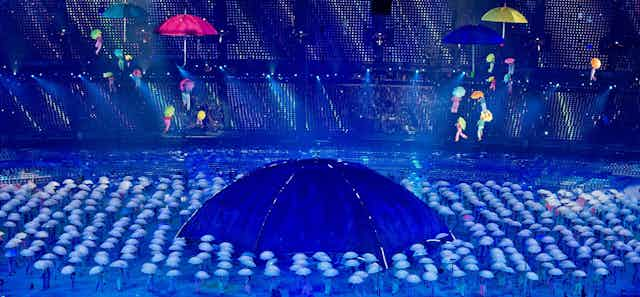The Opening Ceremony of the 2012 London Paralympics was nothing short of a tour de force. But as a new “enlightenment” (the theme for the ceremony), it also raised as many questions about disability as society as it represented a new dawn in olympism.
The coming-home of the Paralympics, which started in Stoke Mandeville in 1948, began with celebrated physicist Stephen Hawking urging athletes to “look at the stars, not your feet”. From there on, the theme of science and the limitless potential of human discovery and inventiveness was threaded into a dazzling spectacle.

Sir Isaac Newton and the discovery of gravitation was brought to life through the humble apple, a revolving book showing the text of the Universal Declaration of Human Rights.
Courtesy of William Shakespeare’s The Tempest, the ceremony had a play within a play – a clever twist with Prospero (played by Sir Ian McKellen) and a disabled Miranda (Nicola Miles-Wilden), declaring: “Oh brave new world, that has such people in’t”.
Prospero’s books took on a huge form, followed by a succession of great moments in science, culminating with the Big Bang. The parade of the athletes themselves, always an extended affair, came to a rousing climax with the entrance of the Great Britain team, resplendent in gold and white outfits, grooving to David Bowie’s immortal line: “we can be heroes, just for one day”.

The great flourishing of creativity, long incubated in the disability arts movement, took centre-stage with a beautiful solo dance by David Toole, Ian Drury’s “Spasticus Austisticus” performed by Graear Theatre Company, and the flawless voice of blind opera singer Denise Leigh was simultaneously interpreted into sign language.
For me, much of the power of the event had to do with the recognition of our social diversity. Finally, we can now see a greater breadth of people with disabilities centre-stage, with starring roles, in such official rituals and global media events.
In this respect, the singing of the national anthem in sign language, as well as with raised voice – to the Queen, the royal party, assembled dignitaries and a packed stadium – holds an importance all of its own.
Yet this magic celebration also powerfully presented the central tensions and problems with the state-of-play in disability and society. It is true we have come a long way, with a still relatively new United Conventions on the Rights of Disabled Persons, widespread support for the National Disability Insurance Scheme in Australia, and some progress on tackling the real barriers and oppression that face people with disabilities in our society.
Compared to the Sydney Paralympics in 2000, athletes with disability are covered in ways more consistent with coverage of other elite spokespeople. We don’t hear so much about the “brave” athletes “overcoming” their disability.
Many now have a celebrity, and feature in everyday life in unremarkable ways – in Qantas informational videos on fastening your seatbelts in a plane, to give but one example.

But much still remains to be done and real issues of exclusion and discrimination are still to be overcome. And our social imagination of disability, and the way much media still reflects this, takes strange forms indeed.
“Brave” althetes have been edged out by “superheroes” (as the British Paralympics video would have it). There is a fascination with South African sprinter, Oscar Pistorius, and how technology can allow us to do things hitherto unthinkable.
And the ABC commentators for the Opening Ceremony found themselves often lost for words, without the ideas, frameworks, or cultural scripts, to communicate the important event unfolding.
In this, the transcendence of the soaring dancers and athletes in today’s ceremony – courtesy of the Aerobility charity flying towards the celestial realm – represents an old, double-edged myth of disability.
It is certainly an evocative way to imagine the plumbing the mysteries of the universe, and exploring our limits as humans. It might also be about the desire to lift us away from what it is to be mortal and all too human, and the lived realities of disability.
The brave new world of disability lies precisely in this double-bind. Disability, as the Paralympics can show us, is becoming the new normal. Our ways of talking about disability, especially in the media, however, still lag well behind the social transformations that are well underway and irreversible – and stand to enlarge, for the better, our notions of what is it to be human.

